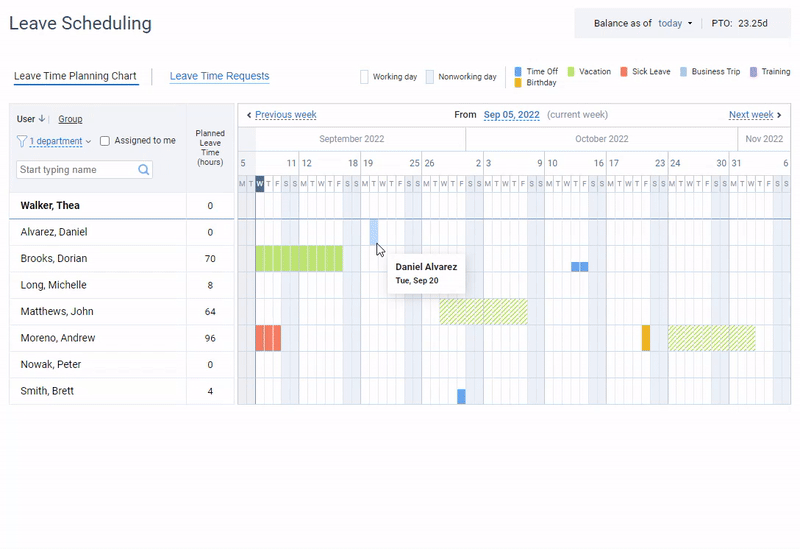Intermittent leave is one of the most frustrating leaves for employers to manage: it’s unpredictable, sporadic and wreaks havoc on internal operations. Simple in theory but hard to administer, intermittent leave can take the form of a reduced schedule leave, generating a lot of confusion for employers and employees.
To help you understand the basics of intermittent leave management, understand your rights and obligations and prevent leave abuse, we’ve compiled the following guide. Read on to learn how intermittent leave works.

What Is Intermittent Leave
Intermittent leave is leave taken in separate blocks of time, rather than for one continuous period of time due to a certain reason. Let’s say, an employee who has a serious health condition is required to pay occasional visits to the hospital. To request an intermittent leave, they need a medical certification addressing the necessity of an intermittent leave or leave on a reduced leave schedule.
Reduced leave schedule is a type of intermittent leave that reduces an employee’s usual number of working hours per week or per day for a period of time. Normally, employees are transferred from a full-time to a part-time position while the leave is in effect.
What is the difference between an intermittent leave and a reduced leave schedule? Both of them are guaranteed under the FMLA and can take up to 12 weeks of unpaid leave within a one-year period. The only difference is that intermittent leave can be taken in unpredictable increments without a warning, while a reduced leave schedule is consistent week-to-week for the length of the leave.
Examples of Intermittent Leave
Intermittent leave can be taken only for all types of family or medical leave. Let’s see a few examples.
Medical necessity
To get a medical certification for requesting intermittent leave, either you or your family member should have a serious health condition. If it’s about your family member, then you can take this leave to provide care or psychological comfort to them. E.g. you or your family member have a chronic condition that can flare up without warning, requiring time off from work.
Birth or placement
Another reason for taking intermittent leave is birth of a child or placement of a healthy child for adoption or foster care. One of the examples of when your request will be fulfilled only with the employer’s permission is when an employee works part-time after the birth of a child, or takes leave in several segments. Although, no employer’s permission is required if an expectant mother or her newborn child has a serious health condition.
Qualifying exigency
An employee is entitled to use intermittent leave due to qualifying exigency such as short-notice deployment, military events, child care activities, financial and legal arrangements.
How Does Intermittent Leave Work
Usually, if an employee is qualified for an FMLA leave, employer consent is not required. The case with intermittent leave request procedure is a little bit trickier.
If an employee needs intermittent leave due to pregnancy, a serious health condition, or a serious illness or injury, this leave request doesn’t require employer’s approval. Other examples may include complications from childbirth, the premature condition of the infant or any other health childbirth or infant-related problems. But to get intermittent leave due to one of these problems, employees are required to provide a medical certificate with a reason for taking a leave, an estimate of how long it’s going to take you and the frequency of taking time off.
However, if requested for the placement for adoption or foster care of a child, employers’ consent is required. The same is true if an employee requests intermittent leave to provide child care after the birth of a child or the placement of an adopted child. If both spouses work for the same employer, they may only take up to 12 weeks of intermittent leave combined to take care of a newborn or a newly adopted child.
Employer Rights Under Intermittent FMLA
Under intermittent FMLA, employers can do the following:
- Request a medical certification from an employee within 15 calendar days
- If you have reason to believe that the certificate is not valid, you may ask them to obtain another medical opinion
- Ask employee to submit a fitness-for-duty certification
- Temporarily move an employee to a similar position with with equivalent pay and employee benefits
Employee Obligations Under Intermittent FMLA
Before qualifying for an intermittent leave, employees must satisfy certain obligations:
- They must provide 30 days’ advance notice to their employer when the need for a leave is foreseeable, otherwise as much advance notice as possible
- Although the nature of intermittent leave is often unpredictable, employees should follow company’s policies on requesting leaves
- Employees need to provide enough information to prove of the need for an intermittent leave
How to Manage Intermittent Leaves Effectively
Managing intermittent laws can raise many questions regarding their management and preventing leave abuse. Here are a few best practices:
- Establish clear policies. Specify compliance conditions and administration details. including intermittent leave requests and tracking to manage employee expectations and minimize confusion.
- Communicate. Make sure your employees are aware of intermittent leave, the conditions for eligibility and the related procedures. When a need arises, inquire about the reasons and time estimates and accompany them through the process.
- Streamline leave management. Leave management can be tricky, so consider either outsourcing leave management or implementing leave management software.
- Train managers. Educate your HR team and managers how to recognize and manage intermittent leaves to ensure a simple leave management process and minimize disturbances to business operations.
- Review state leave laws. Check your policy compliance with state family and medical leave laws. For example, some states like California and New York have their own laws that overlap FMLA.
How to Track Intermittent Leaves
Intermittent leave causes confusion to employers and employees. It requires compliance with the law, documenting it in the company’s policy, a sensitive approach and, most importantly, accurate tracking. As long as intermittent leaves are inconsistent, it’s important to record every minute of time off work, otherwise they may result in costly litigation.
If you are looking for a solution that could register and display employee leaves, calculate leave balances, show employee availability, then you’ll enjoy leave management software. For example, in actiPLANS, you can create custom leaves, specify their accrual rules and set up approval procedures that go along with your company’s policy.

Leave management in actiPLANS – create an unlimited number of leave types, get your team to request and plan their time off and review employee availability
In actiPLANS, your employees can request leaves and set leave statuses in a few clicks using mobile app or online software, see who is absent, who works in the office or from home, plan vacations and other leaves and review their leave balances. Try actiPLANS for free using a 30-day trial (no credit card required).




